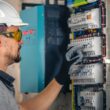Welcome to our comprehensive guide on the Nahco3 Hcl reaction. In this article, we will delve into the details of the reaction between sodium bicarbonate (NaHCO3) and hydrochloric acid (HCl). This chemical reaction is a fundamental topic in chemistry, and understanding its mechanisms and applications can provide valuable insights for both students and enthusiasts of the field.
The Basics of Nahco3 Hcl Reaction
The Nahco3 Hcl reaction involves the interaction between sodium bicarbonate, commonly known as baking soda, and hydrochloric acid, a strong acid. This reaction can be summarized by the following chemical equation:
NaHCO3 + HCl → NaCl + H2O + CO2
Here, sodium bicarbonate reacts with hydrochloric acid to produce sodium chloride (table salt), water, and carbon dioxide gas. This reaction is exothermic, meaning it releases energy in the form of heat.
Factors Affecting the Reaction Rate
The rate of the Nahco3 Hcl reaction can be influenced by several factors:
- Concentration: Higher concentrations of either sodium bicarbonate or hydrochloric acid can lead to a faster reaction rate.
- Temperature: Increasing the temperature generally speeds up chemical reactions, including the Nahco3 Hcl reaction.
- Catalysts: Certain catalysts can accelerate the reaction without being consumed themselves.
Applications of the Nahco3 Hcl Reaction
The Nahco3 Hcl reaction finds application in various fields:
- Cooking: Baking soda is often used as a leavening agent in baking. When it reacts with acidic ingredients like buttermilk or vinegar, it produces carbon dioxide gas, causing the dough to rise.
- Fire Extinguishers: Some fire extinguishers use the Nahco3 Hcl reaction to release carbon dioxide, which displaces oxygen and suppresses the fire.
- Medical Uses: Sodium bicarbonate can be used as an antacid to neutralize excess stomach acid.
Frequently Asked Questions (FAQs)
Q: Is the Nahco3 Hcl reaction dangerous?
A: The reaction itself is not dangerous. However, it produces carbon dioxide gas, which can lead to pressure buildup if the reaction occurs in a closed container.
Q: Can I perform this reaction at home?
A: While the Nahco3 Hcl reaction is relatively safe, it’s important to handle chemicals with care. If you’re conducting experiments at home, follow proper safety protocols and wear appropriate protective gear.
Q: What happens if I ingest sodium bicarbonate and hydrochloric acid?
A: Ingesting these chemicals separately or in concentrated forms can be harmful. Sodium bicarbonate is used as an antacid in controlled doses, and hydrochloric acid is a strong corrosive substance.
Q: How does temperature affect the reaction?
A: Increasing the temperature generally increases the reaction rate by providing more kinetic energy to the molecules, leading to more frequent and energetic collisions.
Q: Can I use the Nahco3 Hcl reaction to inflate balloons?
A: Yes, you can use the reaction to inflate balloons. By mixing baking soda and vinegar (acetic acid), carbon dioxide gas is produced and fills the balloon.
By now, you should have a solid understanding of the Nahco3 Hcl reaction, its underlying chemistry, and its various applications. Whether you’re a student exploring chemical reactions or someone curious about everyday applications, this guide has provided you with valuable insights.




